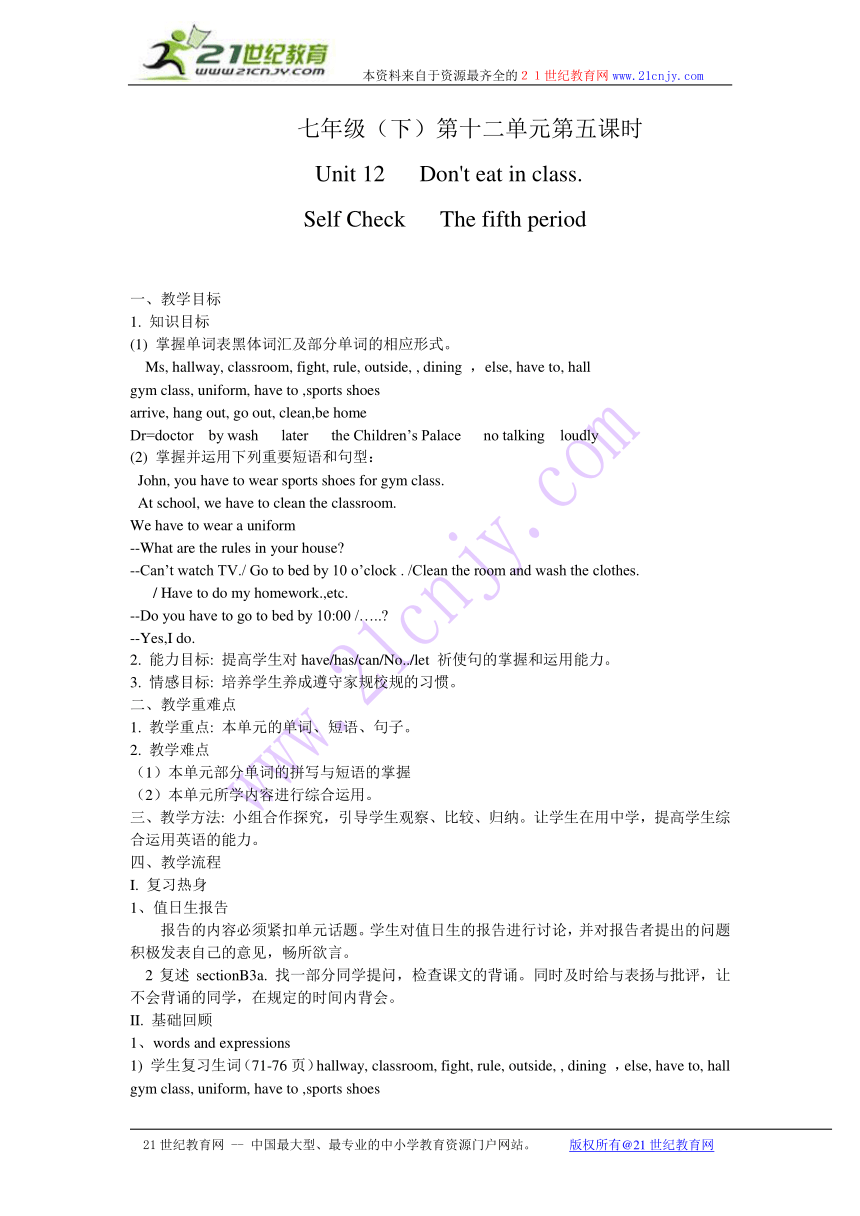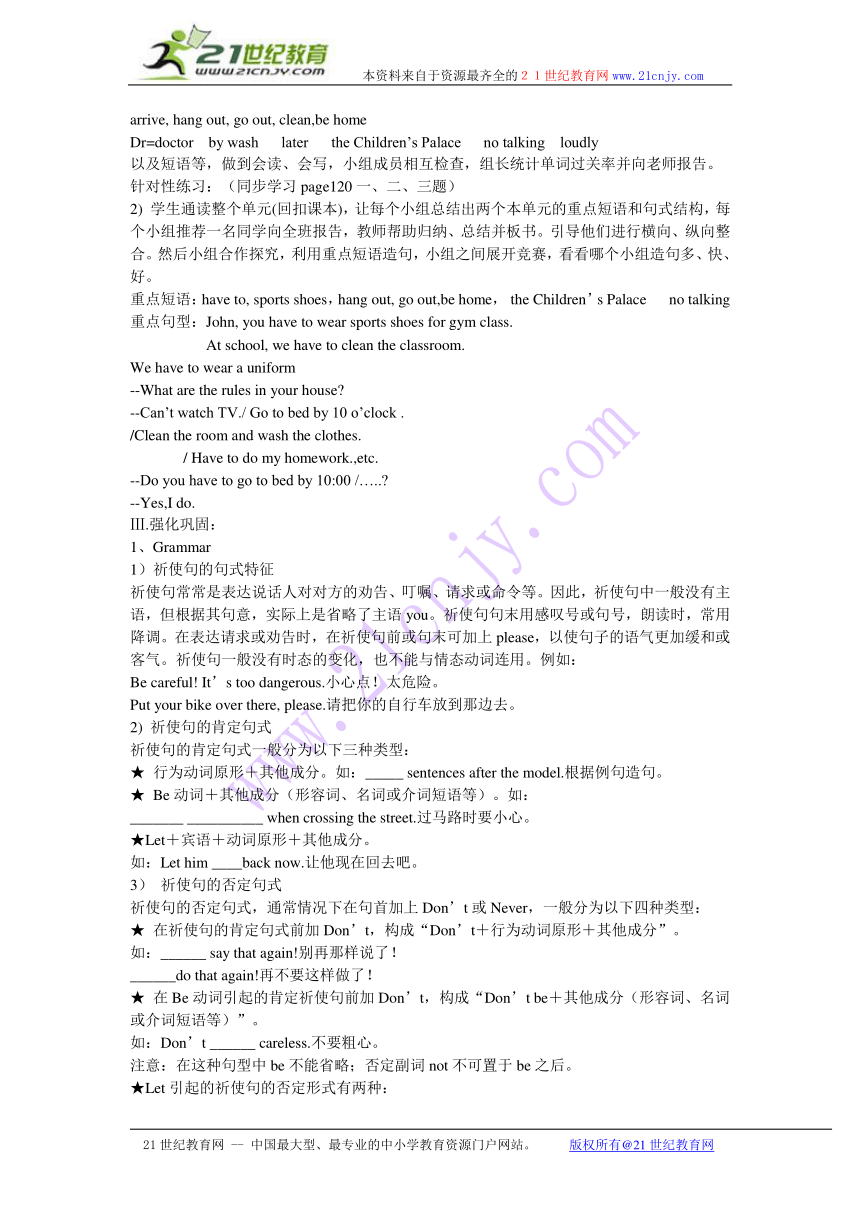Unit 12 Don’t eat in class.Section B
文档属性
| 名称 | Unit 12 Don’t eat in class.Section B |

|
|
| 格式 | rar | ||
| 文件大小 | 15.1KB | ||
| 资源类型 | 教案 | ||
| 版本资源 | 人教新目标(Go for it)版 | ||
| 科目 | 英语 | ||
| 更新时间 | 2011-03-15 11:24:00 | ||
图片预览


文档简介
本资料来自于资源最齐全的21世纪教育网www.21cnjy.com
七年级(下)第十二单元第五课时
Unit 12 Don't eat in class.
Self Check The fifth period
一、教学目标
1. 知识目标
(1) 掌握单词表黑体词汇及部分单词的相应形式。
Ms, hallway, classroom, fight, rule, outside, , dining ,else, have to, hall
gym class, uniform, have to ,sports shoes
arrive, hang out, go out, clean,be home
Dr=doctor by wash later the Children’s Palace no talking loudly
(2) 掌握并运用下列重要短语和句型:
John, you have to wear sports shoes for gym class.
At school, we have to clean the classroom.
We have to wear a uniform
--What are the rules in your house
--Can’t watch TV./ Go to bed by 10 o’clock . /Clean the room and wash the clothes.
/ Have to do my homework.,etc.
--Do you have to go to bed by 10:00 /…..
--Yes,I do.
2. 能力目标: 提高学生对have/has/can/No../let 祈使句的掌握和运用能力。
3. 情感目标: 培养学生养成遵守家规校规的习惯。
二、教学重难点
1. 教学重点: 本单元的单词、短语、句子。
2. 教学难点
(1)本单元部分单词的拼写与短语的掌握
(2)本单元所学内容进行综合运用。
三、教学方法: 小组合作探究,引导学生观察、比较、归纳。让学生在用中学,提高学生综合运用英语的能力。
四、教学流程
I. 复习热身
1、值日生报告
报告的内容必须紧扣单元话题。学生对值日生的报告进行讨论,并对报告者提出的问题积极发表自己的意见,畅所欲言。
2复述sectionB3a. 找一部分同学提问,检查课文的背诵。同时及时给与表扬与批评,让不会背诵的同学,在规定的时间内背会。
II. 基础回顾
1、words and expressions
1) 学生复习生词(71-76页)hallway, classroom, fight, rule, outside, , dining ,else, have to, hall gym class, uniform, have to ,sports shoes
arrive, hang out, go out, clean,be home
Dr=doctor by wash later the Children’s Palace no talking loudly
以及短语等,做到会读、会写,小组成员相互检查,组长统计单词过关率并向老师报告。
针对性练习:(同步学习page120一、二、三题)
2) 学生通读整个单元(回扣课本),让每个小组总结出两个本单元的重点短语和句式结构,每个小组推荐一名同学向全班报告,教师帮助归纳、总结并板书。引导他们进行横向、纵向整合。然后小组合作探究,利用重点短语造句,小组之间展开竞赛,看看哪个小组造句多、快、好。
重点短语:have to, sports shoes,hang out, go out,be home, the Children’s Palace no talking
重点句型:John, you have to wear sports shoes for gym class.
At school, we have to clean the classroom.
We have to wear a uniform
--What are the rules in your house
--Can’t watch TV./ Go to bed by 10 o’clock .
/Clean the room and wash the clothes.
/ Have to do my homework.,etc.
--Do you have to go to bed by 10:00 /…..
--Yes,I do.
Ⅲ.强化巩固:
1、Grammar
1)祈使句的句式特征
祈使句常常是表达说话人对对方的劝告、叮嘱、请求或命令等。因此,祈使句中一般没有主语,但根据其句意,实际上是省略了主语you。祈使句句末用感叹号或句号,朗读时,常用降调。在表达请求或劝告时,在祈使句前或句末可加上please,以使句子的语气更加缓和或客气。祈使句一般没有时态的变化,也不能与情态动词连用。例如:
Be careful! It’s too dangerous.小心点!太危险。
Put your bike over there, please.请把你的自行车放到那边去。
2) 祈使句的肯定句式
祈使句的肯定句式一般分为以下三种类型:
★ 行为动词原形+其他成分。如:_____ sentences after the model.根据例句造句。
★ Be动词+其他成分(形容词、名词或介词短语等)。如:
_______ __________ when crossing the street.过马路时要小心。
★Let+宾语+动词原形+其他成分。
如:Let him ____back now.让他现在回去吧。
3) 祈使句的否定句式
祈使句的否定句式,通常情况下在句首加上Don’t或Never,一般分为以下四种类型:
★ 在祈使句的肯定句式前加Don’t,构成“Don’t+行为动词原形+其他成分”。
如:______ say that again!别再那样说了!
______do that again!再不要这样做了!
★ 在Be动词引起的肯定祈使句前加Don’t,构成“Don’t be+其他成分(形容词、名词或介词短语等)”。
如:Don’t ______ careless.不要粗心。
注意:在这种句型中be不能省略;否定副词not不可置于be之后。
★Let引起的祈使句的否定形式有两种:
(1)Let开头的祈使句,如果后面跟第一、第三人称名词或代词的宾格,可在Let前加Don’t,也可在Let后宾格的名词或代词后面加not。
(2)如果以Let’s开头的祈使句,必须在Let’s后加not。如:
Don’t let me go with her tomorrow.
=________ me ____ go with her tomorrow.
不要让我明天跟她一起去。
2、附:表示禁止的祈使句“No + 动词-ing / 名词”。
例如:No talking ! 禁止说话!
No smoking!禁止吸烟!
3、注意区别have和there be:
have与there be 都可以作“有”解。
① have用来表示各种关系的“所有”,身上“具有(说明人物的外观)”和整体与局部的“含有”。如:
I have a good friend.我有一位好朋友。
Has the book a red cover 这本书的封面是红色的吗
② there be表示存在的关系,表示某处有某人或某物时常用这种句型。如: There are two bikes under the tree.树下有两辆自行车。
There are forty students in our class.我们班有四十名学生。
③ 当表示整体与局部的“含有”时或者是难以判断“有”是所属关系还是存在关系时,have和there be均可使用。如表示“一年有十二个月” :
A year has twelve months.
There are twelve months in a year.
注意:在there be结构中,如果主语不止一个,谓语动词往往和与之最接近的主语在数上保持一致,即我们常说的就近原则。如:
There is a pen,two pencils and four books on the desk.
桌子上有一支钢笔,两支铅笔和四本书。
There are two maps and a picture on the wall.
墙上有两张地图和一幅画。
IV. 语言运用
1、阅读—限时阅读
做《同步学习》Self Check Reading and Writing Page121 I .
要求学生在规定的时间内完成该阅读理解,然后小组交流,质疑解惑,教师点拨。利用本题考查学生的阅读能力,为写作做铺垫。
书面表达
《 同步学习》Self Check Reading and Writing P121 3 短文不得少于50词。
小组讨论后先作口头报告,然后再落实到笔头,形成书面表达,向全班展示,两位同学写在黑板上教师面批。_
V. 作业布置 1. 充实、整理个人笔记
2. 完成《配套学习》相关题目。
五、教学反思:
本单元是让学生学会谈论一些规章制度,比如说:--Can we eat in school – We can eat in the dining room, but we can’t eat in the classrooms./ --Can students wear hats in school –Yes, we can. /No, we can’t. 重在对学生进行思想教育,让学生弄明白在什么地方该干什么,不该干什么。通过学习, 学生可以表达一些句子,但要使学生在实际生活中真正做到,还需要日常学习生活中的灌输运用。
【课时达标】
一、根据句意和首字母提示,完成单词。
1 Don’t break r_______ in the school library.
2 Nick is very friendly to everyone. He never f_______.
3 it’s time for lunch. Let’s go to the d_______ hall.
4 We have our PE class in the g_____.
5 Don’t run in the h_______. It’s a little dangerous.
6 There are ________ _______ __________(太多规则) in Zhao Pei’s house.
7 “No talking” is one of the library r________.
8 We have to wear u__________ at school.
9I have a new bike. I r______ it to school every day.
10 W______________ your hands before each meal
二、根据句意,用所给单词的适当形式填空。
1 –Where is Rice Do you know
– She is in the _______(dine) hall. She is having lunch there.
2 Today I want to wear my ________(sport) shoes because we have a gym class.
3 I think these backpacks are __________(child).
4 –Can you help me with my Chinese
– I’m sorry. I can’t. I can help you ________(late).
5 When the teacher asks you a question, you should answer ________(loud).
三、句型转换,每空一词。
1 You can put the book on the table.(改为否定祈使句)
____ _____the book on the table.
2 My sister often helps me with my English. (改为同义句)
My sister often helps me _______ __________English.
3 My father is medium build and has short straight hair(划线提问)
What ________ your father __________ __________
4 At home we must finish our homework. (改为同义句)
AT home we ________ __________finish our homework.
5 Give me a cup of coffee. (改为否定句)
______ ______ me a cup of coffee,
四、句子翻译
1 你学校的规章制度是什么? What are the ______ ______your school
2 现在不要练习你的书法。 Please ________ ________your handwriting now.
3 在上学的晚上,戴维从不出去。Dave _______ _______ _____ _____school nights.
4 你弟弟在哪儿?他还在睡觉
-Where’s your brother – He is still _____ _______.
5 你叔叔还去过上海什么别的地方?
______ ________did your uncle go to Shanghai
【答案】
一、1.rules 2. fight 3. dining 4. gym 5. hallways
6. so many rules 7. rules 8. uniforms 9.ride 10. Wash
二、1.dining, 2. sports. 3.children’s 4. later 5. loudly
三、1. Don’t put 2. to learn 3. does, look like 4. have to 5. Don't give
四、1. rules in 2. don’t practice 3. never goes out on
4. in bed 5. Where else
21世纪教育网 -- 中国最大型、最专业的中小学教育资源门户网站。 版权所有@21世纪教育网
七年级(下)第十二单元第五课时
Unit 12 Don't eat in class.
Self Check The fifth period
一、教学目标
1. 知识目标
(1) 掌握单词表黑体词汇及部分单词的相应形式。
Ms, hallway, classroom, fight, rule, outside, , dining ,else, have to, hall
gym class, uniform, have to ,sports shoes
arrive, hang out, go out, clean,be home
Dr=doctor by wash later the Children’s Palace no talking loudly
(2) 掌握并运用下列重要短语和句型:
John, you have to wear sports shoes for gym class.
At school, we have to clean the classroom.
We have to wear a uniform
--What are the rules in your house
--Can’t watch TV./ Go to bed by 10 o’clock . /Clean the room and wash the clothes.
/ Have to do my homework.,etc.
--Do you have to go to bed by 10:00 /…..
--Yes,I do.
2. 能力目标: 提高学生对have/has/can/No../let 祈使句的掌握和运用能力。
3. 情感目标: 培养学生养成遵守家规校规的习惯。
二、教学重难点
1. 教学重点: 本单元的单词、短语、句子。
2. 教学难点
(1)本单元部分单词的拼写与短语的掌握
(2)本单元所学内容进行综合运用。
三、教学方法: 小组合作探究,引导学生观察、比较、归纳。让学生在用中学,提高学生综合运用英语的能力。
四、教学流程
I. 复习热身
1、值日生报告
报告的内容必须紧扣单元话题。学生对值日生的报告进行讨论,并对报告者提出的问题积极发表自己的意见,畅所欲言。
2复述sectionB3a. 找一部分同学提问,检查课文的背诵。同时及时给与表扬与批评,让不会背诵的同学,在规定的时间内背会。
II. 基础回顾
1、words and expressions
1) 学生复习生词(71-76页)hallway, classroom, fight, rule, outside, , dining ,else, have to, hall gym class, uniform, have to ,sports shoes
arrive, hang out, go out, clean,be home
Dr=doctor by wash later the Children’s Palace no talking loudly
以及短语等,做到会读、会写,小组成员相互检查,组长统计单词过关率并向老师报告。
针对性练习:(同步学习page120一、二、三题)
2) 学生通读整个单元(回扣课本),让每个小组总结出两个本单元的重点短语和句式结构,每个小组推荐一名同学向全班报告,教师帮助归纳、总结并板书。引导他们进行横向、纵向整合。然后小组合作探究,利用重点短语造句,小组之间展开竞赛,看看哪个小组造句多、快、好。
重点短语:have to, sports shoes,hang out, go out,be home, the Children’s Palace no talking
重点句型:John, you have to wear sports shoes for gym class.
At school, we have to clean the classroom.
We have to wear a uniform
--What are the rules in your house
--Can’t watch TV./ Go to bed by 10 o’clock .
/Clean the room and wash the clothes.
/ Have to do my homework.,etc.
--Do you have to go to bed by 10:00 /…..
--Yes,I do.
Ⅲ.强化巩固:
1、Grammar
1)祈使句的句式特征
祈使句常常是表达说话人对对方的劝告、叮嘱、请求或命令等。因此,祈使句中一般没有主语,但根据其句意,实际上是省略了主语you。祈使句句末用感叹号或句号,朗读时,常用降调。在表达请求或劝告时,在祈使句前或句末可加上please,以使句子的语气更加缓和或客气。祈使句一般没有时态的变化,也不能与情态动词连用。例如:
Be careful! It’s too dangerous.小心点!太危险。
Put your bike over there, please.请把你的自行车放到那边去。
2) 祈使句的肯定句式
祈使句的肯定句式一般分为以下三种类型:
★ 行为动词原形+其他成分。如:_____ sentences after the model.根据例句造句。
★ Be动词+其他成分(形容词、名词或介词短语等)。如:
_______ __________ when crossing the street.过马路时要小心。
★Let+宾语+动词原形+其他成分。
如:Let him ____back now.让他现在回去吧。
3) 祈使句的否定句式
祈使句的否定句式,通常情况下在句首加上Don’t或Never,一般分为以下四种类型:
★ 在祈使句的肯定句式前加Don’t,构成“Don’t+行为动词原形+其他成分”。
如:______ say that again!别再那样说了!
______do that again!再不要这样做了!
★ 在Be动词引起的肯定祈使句前加Don’t,构成“Don’t be+其他成分(形容词、名词或介词短语等)”。
如:Don’t ______ careless.不要粗心。
注意:在这种句型中be不能省略;否定副词not不可置于be之后。
★Let引起的祈使句的否定形式有两种:
(1)Let开头的祈使句,如果后面跟第一、第三人称名词或代词的宾格,可在Let前加Don’t,也可在Let后宾格的名词或代词后面加not。
(2)如果以Let’s开头的祈使句,必须在Let’s后加not。如:
Don’t let me go with her tomorrow.
=________ me ____ go with her tomorrow.
不要让我明天跟她一起去。
2、附:表示禁止的祈使句“No + 动词-ing / 名词”。
例如:No talking ! 禁止说话!
No smoking!禁止吸烟!
3、注意区别have和there be:
have与there be 都可以作“有”解。
① have用来表示各种关系的“所有”,身上“具有(说明人物的外观)”和整体与局部的“含有”。如:
I have a good friend.我有一位好朋友。
Has the book a red cover 这本书的封面是红色的吗
② there be表示存在的关系,表示某处有某人或某物时常用这种句型。如: There are two bikes under the tree.树下有两辆自行车。
There are forty students in our class.我们班有四十名学生。
③ 当表示整体与局部的“含有”时或者是难以判断“有”是所属关系还是存在关系时,have和there be均可使用。如表示“一年有十二个月” :
A year has twelve months.
There are twelve months in a year.
注意:在there be结构中,如果主语不止一个,谓语动词往往和与之最接近的主语在数上保持一致,即我们常说的就近原则。如:
There is a pen,two pencils and four books on the desk.
桌子上有一支钢笔,两支铅笔和四本书。
There are two maps and a picture on the wall.
墙上有两张地图和一幅画。
IV. 语言运用
1、阅读—限时阅读
做《同步学习》Self Check Reading and Writing Page121 I .
要求学生在规定的时间内完成该阅读理解,然后小组交流,质疑解惑,教师点拨。利用本题考查学生的阅读能力,为写作做铺垫。
书面表达
《 同步学习》Self Check Reading and Writing P121 3 短文不得少于50词。
小组讨论后先作口头报告,然后再落实到笔头,形成书面表达,向全班展示,两位同学写在黑板上教师面批。_
V. 作业布置 1. 充实、整理个人笔记
2. 完成《配套学习》相关题目。
五、教学反思:
本单元是让学生学会谈论一些规章制度,比如说:--Can we eat in school – We can eat in the dining room, but we can’t eat in the classrooms./ --Can students wear hats in school –Yes, we can. /No, we can’t. 重在对学生进行思想教育,让学生弄明白在什么地方该干什么,不该干什么。通过学习, 学生可以表达一些句子,但要使学生在实际生活中真正做到,还需要日常学习生活中的灌输运用。
【课时达标】
一、根据句意和首字母提示,完成单词。
1 Don’t break r_______ in the school library.
2 Nick is very friendly to everyone. He never f_______.
3 it’s time for lunch. Let’s go to the d_______ hall.
4 We have our PE class in the g_____.
5 Don’t run in the h_______. It’s a little dangerous.
6 There are ________ _______ __________(太多规则) in Zhao Pei’s house.
7 “No talking” is one of the library r________.
8 We have to wear u__________ at school.
9I have a new bike. I r______ it to school every day.
10 W______________ your hands before each meal
二、根据句意,用所给单词的适当形式填空。
1 –Where is Rice Do you know
– She is in the _______(dine) hall. She is having lunch there.
2 Today I want to wear my ________(sport) shoes because we have a gym class.
3 I think these backpacks are __________(child).
4 –Can you help me with my Chinese
– I’m sorry. I can’t. I can help you ________(late).
5 When the teacher asks you a question, you should answer ________(loud).
三、句型转换,每空一词。
1 You can put the book on the table.(改为否定祈使句)
____ _____the book on the table.
2 My sister often helps me with my English. (改为同义句)
My sister often helps me _______ __________English.
3 My father is medium build and has short straight hair(划线提问)
What ________ your father __________ __________
4 At home we must finish our homework. (改为同义句)
AT home we ________ __________finish our homework.
5 Give me a cup of coffee. (改为否定句)
______ ______ me a cup of coffee,
四、句子翻译
1 你学校的规章制度是什么? What are the ______ ______your school
2 现在不要练习你的书法。 Please ________ ________your handwriting now.
3 在上学的晚上,戴维从不出去。Dave _______ _______ _____ _____school nights.
4 你弟弟在哪儿?他还在睡觉
-Where’s your brother – He is still _____ _______.
5 你叔叔还去过上海什么别的地方?
______ ________did your uncle go to Shanghai
【答案】
一、1.rules 2. fight 3. dining 4. gym 5. hallways
6. so many rules 7. rules 8. uniforms 9.ride 10. Wash
二、1.dining, 2. sports. 3.children’s 4. later 5. loudly
三、1. Don’t put 2. to learn 3. does, look like 4. have to 5. Don't give
四、1. rules in 2. don’t practice 3. never goes out on
4. in bed 5. Where else
21世纪教育网 -- 中国最大型、最专业的中小学教育资源门户网站。 版权所有@21世纪教育网
同课章节目录
- Unit 1 Can you play the guitar?
- Section A
- Section B
- Unit 2 What time do you go to school?
- Section A
- Section B
- Unit 3 How do you get to school?
- Section A
- Section B
- Unit 4 Don't eat in class.
- Section A
- Section B
- Unit 5 Why do you like pandas?
- Section A
- Section B
- Unit 6 I'm watching TV.
- Section A
- Section B
- Review of Units 1-6
- Unit 7 It's raining!
- Section A
- Section B
- Unit 8 Is there a post office near here?
- Section A
- Section B
- Unit 9 What does he look like?
- Section A
- Section B
- Unit 10 I'd like some noodles.
- Section A
- Section B
- Unit 11 How was your school trip?
- Section A
- Section B
- Unit 12 What did you do last weekend?
- Section A
- Section B
